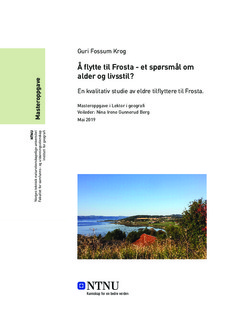| dc.contributor.advisor | Berg, Nina Irene Gunnerud | |
| dc.contributor.author | Krog, Guri Fossum | |
| dc.date.accessioned | 2019-08-25T14:07:35Z | |
| dc.date.available | 2019-08-25T14:07:35Z | |
| dc.date.issued | 2019 | |
| dc.identifier.uri | http://hdl.handle.net/11250/2610880 | |
| dc.description.abstract | Det norske samfunnet har en grå tsunami i vente. Eldre har bedre helse og lever lenger enn før. Men hvor bor de? Flytting fra rurale til urbane områder har preget det norske bosettingsmønsteret siden etterkrigstiden og frem til i dag. Fordi flere barn fødes og vokser opp i byer og sentrale strøk, har urbaniseringen hatt en forsterkende effekt på det sentraliserende bosettingsmønsteret de siste tiårene. Forskning viser en trend hvor elder flytter fra rurale til urbane områder etter ønske om mindre bolig samt et større vare- og tjenestetilbud. Følgelig utgjør eldre også et bidrag i sentraliseringen av bosettingsmønsteret. Likevel, går noen mot strømmen. I lys av et livsløpsperspektiv, er formålet med denne oppgaven å få innsikt i hvorfor noen eldre velger å bosette seg i rurale områder uten å ha tilknytning til stedene fra før. På bakgrunn av dette, omhandler denne studien mer konkret tilflytting av eldre til landbrukskommunen Frosta i Trøndelag fylke.
Oppgaven tar utgangspunkt i en kvalitativ studie hvor et utvalg eldre innflyttere i Frosta, som ikke hadde tilknytning til kommunen fra før, har blitt intervjuet. Basert på et livsløpsperspektiv, blir informantenes flyttemotiver diskutert i lys av teorier om flytting og ruralitet. Siden informantene enten var pensjonister eller uføretrygdet da beslutningen om å flytte ble tatt, blir også alder og spørsmålet om hva det vil si å være eldre sentralt.
I oppgaven ser jeg på hvordan et levd liv har betydning for flytte- og bostedsvalg i eldre alder. Informantene forklarer sitt flytte- og bostedsvalg på bakgrunn av ønsket om å bo i landlige omgivelser. Nærhet til familie er også et motiv som er sentralt. | |
| dc.description.abstract | A silver tsunami is headed towards the Norwegian society. The older generation lives longer and are healthier than ever before. But where do they live? Relocation from rural to urban spaces has been a feature of the Norwegian settlement pattern since the post-war era. The increase in people being born and growing up in central areas like cities has resulted in urbanization becoming a reinforcing effect on the centralizing settlement pattern during the last decades. Research shows that relocating from rural to urban areas by elders are motivated by the larger array of goods and services, as well as a wish for a smaller living-space. Elders are thus contributing to the centralization of the settlement pattern. Whilst this is the trend, some elders go against the grain. The purpose of this thesis is to gain insight on the reasons why some elders choose to relocate to the rural areas without any prior attachments to said area. This will be discussed by looking at newcomers in the municipality of Frosta in Trøndelag county.
The base of this thesis is a qualitative study in which a selection of elders that have moved to Frosta is interviewed. These elders had no attachment to the municipality prior to the move. The motives for relocating will be discussed in the light of a lifetime perspective and through theory on migration and rurality. The informants age and what it means to be older is also central to the discussion, as the informants consisted of retirees and people with disability pensions.
In the thesis, I have looked at how a lived life is of importance in regard to relocation and choice of residence for the older generations. The informants themselves explains that living in more rural surroundings is part of the reason why they have chosen to relocate. Proximity to family is also a central motive. | |
| dc.language | nob | |
| dc.publisher | NTNU | |
| dc.title | Å flytte til Frosta - et spørsmål om alder og livsstil? | |
| dc.type | Master thesis | |
